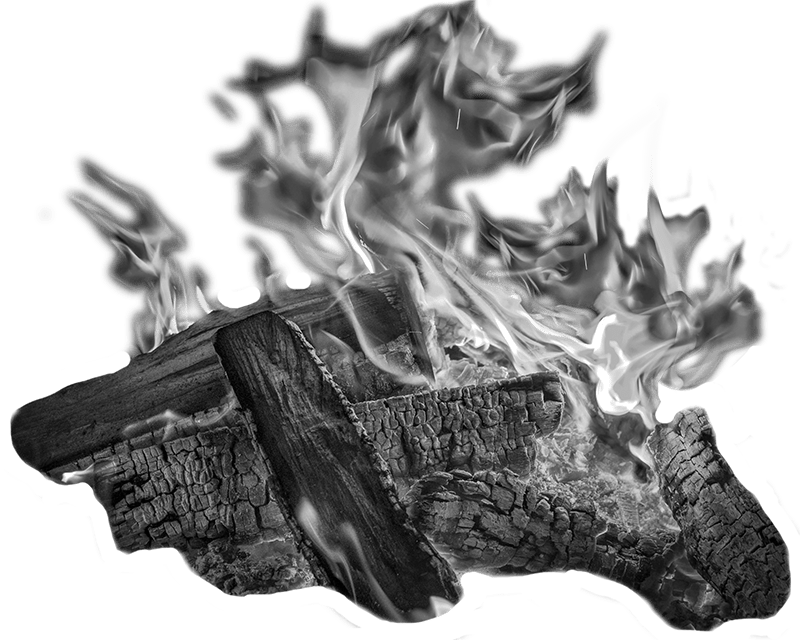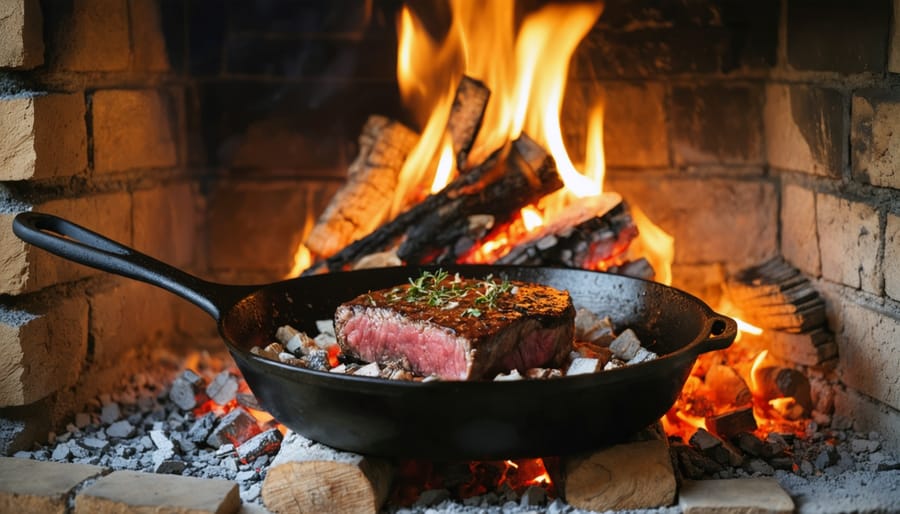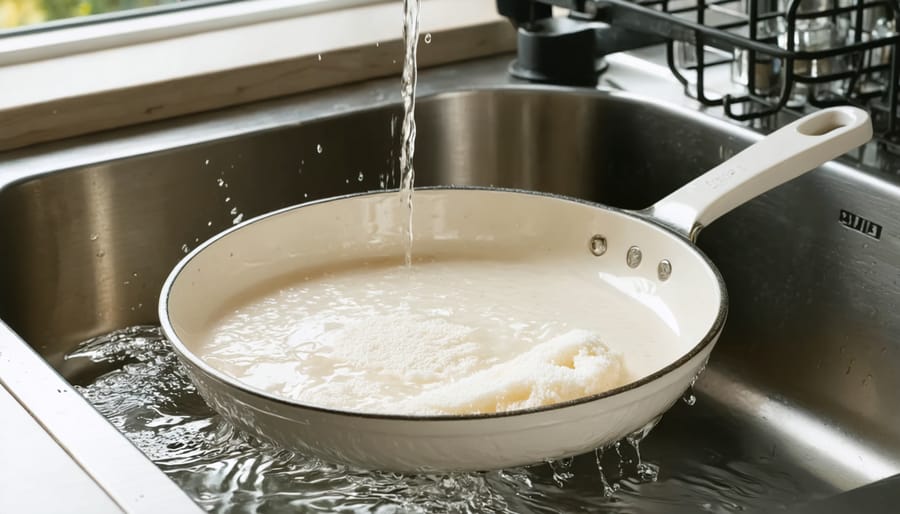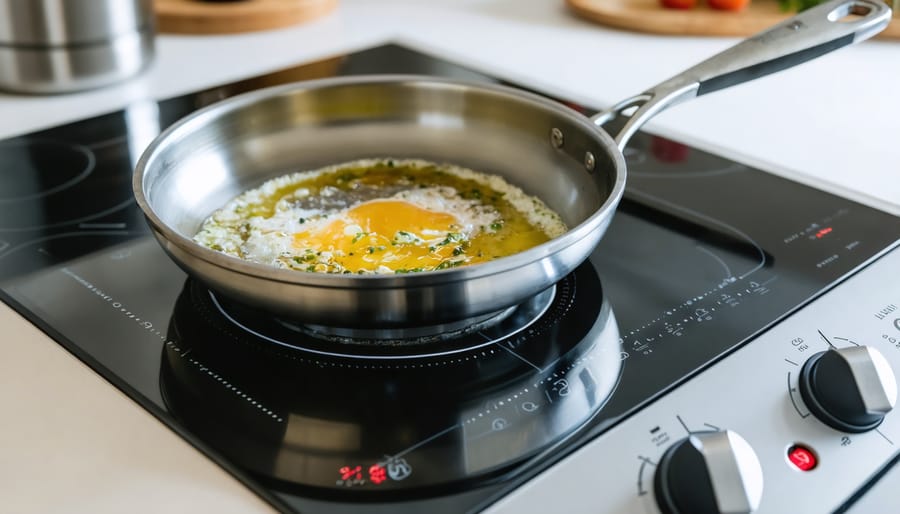Understand that EPA wood burning standards aren’t bureaucratic hurdles—they’re your pathway to a cleaner, more enjoyable outdoor fire experience. Choose EPA-certified fire pits or retrofitting options that reduce particulate emissions by up to 90%, transforming those frustrating smoky fire pit problems into evenings filled with warmth and clear air. Burn only properly seasoned hardwood with moisture content below 20%, which ignites faster, produces significantly less smoke, and generates more heat per log than wet or softwood alternatives. Position your fire pit to optimize airflow and maintain smaller, hotter fires rather than large smoldering ones—this approach maximizes combustion efficiency while minimizing smoke output and environmental impact. These EPA-aligned practices don’t just satisfy regulations; they elevate your backyard gatherings by creating the warm, inviting atmosphere you’ve been seeking without the choking smoke that drives guests indoors. Master these fundamentals and you’ll discover that compliant burning actually enhances your outdoor living space while protecting air quality for your entire neighborhood.
What EPA Wood Burning Standards Actually Mean for Your Backyard
Let’s clear up the confusion around EPA wood burning standards, because they’re actually more straightforward than most people think. The EPA doesn’t regulate recreational fire pits or outdoor fireplaces in your backyard the same way they regulate indoor wood-burning appliances. That’s an important distinction worth understanding.
For indoor fireplaces and wood stoves, EPA certification is the gold standard. These appliances must meet strict emissions limits, typically producing no more than 2.0 grams of smoke per hour for newer models. When you see that EPA certification label, you’re looking at a fireplace or stove that’s been rigorously tested for efficiency and clean burning. This matters because certified appliances burn up to one-third less wood while producing 70% less smoke than older, non-certified models.
Your backyard fire pit, however, operates in a different category. While there’s no EPA certification program specifically for outdoor fire pits, the principles behind EPA standards still apply and can dramatically improve your outdoor experience. Think of it this way: EPA regulations focus on combustion efficiency and reducing particulate matter. When you apply these same principles to your fire pit by using properly seasoned wood, maintaining good airflow, and building efficient fires, you’re creating the same benefits without needing a certification stamp.
Here’s where it gets practical for your lifestyle. EPA-aligned burning practices mean less smoke drifting into your face during gatherings, cleaner air for your neighbors, and more heat from less wood. Whether you’re upgrading to an EPA-certified indoor fireplace or simply improving your outdoor fire pit techniques, you’re investing in both environmental responsibility and better enjoyment.
The real takeaway? EPA wood burning standards aren’t about limiting your enjoyment of fire. They’re about maximizing efficiency and minimizing smoke, which means better warmth, clearer views of the flames, and a more pleasant atmosphere for everyone around your fire.

The Real Benefits of EPA-Compliant Wood Burning in Fire Pits
Cleaner Burns Mean More Time Enjoying, Less Time Choking
Modern EPA-certified wood burning systems transform your outdoor gatherings from smoky affairs into comfortable, breathable experiences. If you’ve ever dealt with excessive smoke driving guests away from your fire pit or leaving everyone with stinging eyes and smoky clothes, you’ll appreciate what cleaner burning technology delivers.
EPA-compliant fire pits and burning practices reduce particulate emissions by up to 70% compared to traditional setups. What does this mean for your backyard? Your guests can actually sit around the fire without constantly shifting positions to avoid smoke clouds. Conversations flow naturally when people aren’t coughing or rubbing their eyes. Clothes and hair stay fresher, meaning no one needs to immediately shower after an evening by the fire.
The comfort factor extends beyond just smoke reduction. Cleaner combustion creates more consistent heat with less ash and residue. You’ll spend less time managing the fire and more time enjoying the warmth and ambiance. Plus, your neighbors will appreciate the reduced smoke drift, making your outdoor fires a neighborhood asset rather than a nuisance. This is eco-friendly heating that actually enhances your lifestyle rather than compromising comfort for compliance.
Burn Less Wood, Stay Warm Longer
Here’s the beauty of EPA-certified wood burning: you’ll get more heat from less wood. These modern systems squeeze significantly more energy from every log, meaning your woodpile lasts longer and your wallet thanks you. Think of it as getting 30-40% more warmth from the same amount of firewood compared to older, uncertified units.
This improved efficiency happens because EPA-compliant designs burn wood more completely, transforming what would’ve been wasted smoke into usable heat instead. You’re not just reducing emissions—you’re actually capturing energy that traditional fire pits let drift away into the night sky. For homeowners who enjoy regular outdoor fires, this translates to fewer trips to replenish your wood supply and genuine cost savings over time. It’s eco-friendly heating that makes practical sense, turning your outdoor space into a sustainable gathering spot where you can enjoy those cozy evenings without constantly feeding the flames.
Your Neighbors Will Thank You
Nobody wants to be that neighbor whose smoky fire pit sends everyone else running indoors. When you switch to EPA-compliant wood burning practices, you’re doing more than following regulations—you’re being a considerate community member. The dramatic reduction in visible smoke and particulate matter means cleaner air for everyone around you.
Many municipalities have implemented wood burning restrictions, especially during air quality alert days or in areas with temperature inversions. Using EPA-certified equipment and proper burning techniques keeps you on the right side of these local ordinances. Some communities even offer rebates or incentives for upgrading to cleaner-burning systems.
Beyond regulations, there’s the social aspect to consider. EPA-compliant burning produces less of that acrid smell that clings to clothing and drifts through open windows. Your neighbors can enjoy their outdoor spaces while you enjoy yours—a true win-win that fosters better neighborhood relationships.
Choosing the Right Wood: The Foundation of EPA-Friendly Fire Pits
Why Seasoned Hardwood Changes Everything
Here’s the truth: even the best EPA-certified fire pit can’t overcome wet or poorly seasoned wood. Moisture content makes all the difference between a crackling, efficient fire and a smoky, frustrating experience.
Properly seasoned hardwood contains 20% moisture or less. When wood holds more moisture than this, it produces excessive smoke, creates creosote buildup, and generates far less heat because energy is wasted evaporating water instead of warming your space. Fresh-cut wood can contain 50% moisture or more, which explains why “green” wood hisses, pops, and smolders rather than burns cleanly.
Seasoning takes time. Most hardwoods like oak, maple, or ash need 6-12 months of proper drying, while denser woods may require up to two years. The wood should be split, stacked off the ground with good airflow, and covered on top while leaving the sides exposed to wind.
How can you tell if your wood is ready? Look for these signs: cracks or splits in the end grain, bark that falls off easily, a hollow sound when two pieces knock together, and noticeably lighter weight compared to fresh-cut wood. A moisture meter takes the guesswork out, giving you precise readings for under twenty dollars.
Think of seasoned wood as the foundation of eco-friendly burning. It’s not just about following regulations—it’s about creating warmth efficiently while respecting your neighborhood and the environment. When you burn dry, seasoned hardwood, everyone benefits from cleaner air and a more enjoyable fire.
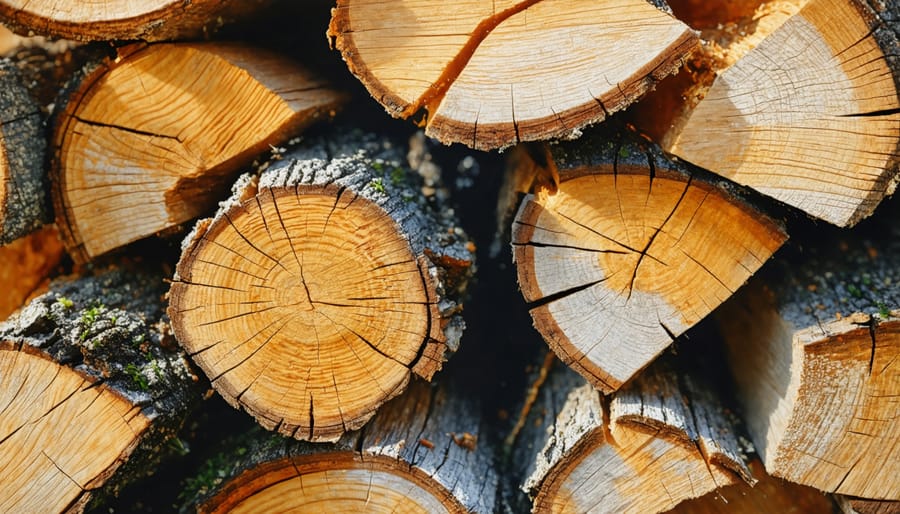
Woods to Avoid for Cleaner, Safer Burns
Not all wood is created equal when it comes to clean, EPA-compliant burning. Choosing the right fuel makes a dramatic difference in your fire’s performance and the air quality around your home.
Treated lumber tops the list of woods to never burn. Pressure-treated wood, painted lumber, or anything coated with stains or preservatives releases toxic chemicals when burned. These materials contain arsenic, copper compounds, and other hazardous substances that become airborne pollutants, posing serious health risks to you and your neighbors.
Green or freshly cut wood is another culprit for excessive smoke production. Wood that hasn’t been properly seasoned contains too much moisture—sometimes 50% or more by weight. When you try burning it, much of the fire’s energy goes toward evaporating that water rather than producing heat. The result? Dense smoke, creosote buildup, and wasted fuel that undermines everything EPA guidelines aim to achieve.
Softwoods like pine, fir, and cedar deserve special mention. While they’re not prohibited, they contain high levels of resin that creates more smoke and sparks than hardwoods. They also burn faster, requiring more frequent refueling. If you’re committed to cleaner burns, stick with seasoned hardwoods like oak, maple, or ash.
The simple truth is this: what you burn matters as much as how you burn it. By avoiding these problematic woods and choosing properly seasoned hardwood instead, you’ll enjoy cleaner fires, better efficiency, and peace of mind knowing you’re being a responsible neighbor and environmental steward.
Fire Pit Design Features That Support Cleaner Burning

Airflow is Your Secret Weapon
Here’s the secret that transforms an ordinary fire into something extraordinary: proper airflow. When you understand how oxygen moves through your fire pit, you’re not just building fires – you’re orchestrating them.
Think of your EPA-certified wood burner as having its own breathing system. Those strategically placed air intake holes aren’t just design features; they’re the key to creating fires that burn hotter and cleaner. When air enters from below the fire, it feeds oxygen directly to the combustion zone. This creates what experts call “secondary combustion” – a fancy term for burning the smoke before it ever leaves your fire pit.
The beauty of modern ventilation systems is how they work with nature, not against it. As flames consume oxygen, they naturally draw fresh air through the intake holes. This continuous flow creates a self-sustaining cycle that keeps your fire burning efficiently. The result? Temperatures hot enough to burn wood more completely, which means less smoke, fewer emissions, and significantly less ash to clean up later.
Many homeowners don’t realize that a smoldering, smoky fire isn’t just unpleasant – it’s also wasteful. That smoke represents unburned fuel literally floating away. When you optimize airflow, you’re extracting more heat from every log while keeping your backyard comfortable for everyone. Adjustable air controls on EPA-compliant models let you fine-tune the oxygen supply, giving you complete command over flame intensity and burn duration. It’s like having a thermostat for your outdoor fire.
The Right Size and Shape Matter
The dimensions of your fire pit play a surprisingly significant role in how efficiently it burns and how much smoke it produces. Think of it as creating the perfect environment for wood to do what it does best: burn cleanly and completely.
For optimal EPA-compliant burning, aim for a fire pit that’s 36 to 48 inches in diameter. This size range allows adequate airflow while containing the fire effectively. The depth matters too—a bowl depth of 12 to 18 inches creates the ideal balance between oxygen circulation and heat retention.
The shape also influences performance. Round or bowl-shaped fire pits naturally promote better air circulation compared to square designs with corners where combustion can stall. When exploring various fire pit design options, consider models with raised grates or perforated bottoms that allow air to feed the fire from below, mimicking the airflow patterns that EPA-certified wood stoves use to achieve cleaner burns.
Avoid oversized fire pits that tempt you to build massive fires—these create more smoke and waste wood. Similarly, shallow pits expose flames to wind interference, causing inefficient burning. The right proportions create a sweet spot where wood burns thoroughly, producing minimal smoke while maximizing the warmth and ambiance you’re seeking.
Material Choices That Improve Performance
The materials inside your EPA-certified wood burning system play a crucial role in achieving those cleaner, hotter burns that regulators are looking for. Think of it as upgrading from basic to premium—the right materials make all the difference.
Firebrick linings are game-changers for maintaining high combustion temperatures. These dense, heat-retaining bricks create an insulated chamber that reflects heat back into the firebox, keeping flames hotter and burning wood more completely. The result? Less smoke, more warmth, and fewer emissions that drift into your neighbor’s yard.
Ceramic inserts and baffle systems work similarly by trapping heat inside the burn chamber. This retained heat is what transforms your fire pit from a smoky nuisance into an efficient heating source. Many EPA-compliant models feature stainless steel components that withstand these higher temperatures without degrading.
If you’re upgrading an existing setup, consider adding a secondary combustion chamber—these clever designs give unburned gases a second chance to ignite, dramatically reducing smoke output. The investment in quality materials pays dividends through improved performance and reduced wood consumption, making your outdoor gatherings more enjoyable while respecting environmental standards.
Building and Maintaining an EPA-Friendly Fire

The Top-Down Method for Minimal Smoke Startup
If you’ve always started fires by placing kindling on the bottom and logs on top, you’re about to discover a game-changer. The top-down method flips everything you know about fire-starting, and it’s one of the most effective ways to meet EPA standards while dramatically reducing smoke.
Here’s how it works: Start by placing your largest logs on the bottom of your fire pit or fireplace, running parallel to each other. Add a second layer of slightly smaller logs perpendicular to the first. Continue this crisscross pattern with progressively smaller pieces until you reach the top. Finally, place your kindling and fire starter on the very top layer.
When you light the fire from above, it burns downward gradually and methodically. This creates a more complete combustion process because the fire preheats the wood below as it descends, releasing gases that burn cleanly rather than escaping as smoke. The result is a fire that starts with minimal smoke and maintains cleaner burning throughout.
This technique works beautifully because it mimics how commercial EPA-certified stoves are designed to burn. You’ll notice less smoke within the first few minutes compared to traditional bottom-up methods, and you won’t need to constantly tend the fire as it establishes itself. The wood burns more efficiently, meaning you’ll use less fuel while generating more heat. Plus, your neighbors will appreciate the cleaner burn, especially during those cozy evening gatherings around your outdoor fire pit.
Keeping Your Fire Pit Clean for Better Performance
A clean fire pit isn’t just about appearances—it’s essential for maintaining efficient, EPA-friendly burns that produce less smoke and more heat. Think of your fire pit like any other important home feature: regular maintenance keeps it performing at its best.
Start with ash management, which directly impacts air flow and combustion quality. Remove excess ash regularly, but here’s an insider tip: leave about an inch of ash at the bottom. This thin layer actually insulates the fire pit floor and helps reflect heat upward, supporting more complete combustion. Once ash builds up beyond two inches, though, it restricts airflow and hampers efficient burning.
Before each use, clear away any debris like leaves, twigs, or moisture that may have accumulated. Wet debris creates extra smoke and prevents your fire from reaching optimal temperatures quickly. A simple sweep-out takes minutes but makes a noticeable difference in how cleanly your fire burns.
Seasonal care matters too. As outdoor temperatures drop and you’re using your fire pit more frequently, inspect the structure for cracks or damage that might affect air circulation. Clean the fire pit thoroughly at season’s end, removing all ash and debris before covering or storing components.
Don’t forget about your fire pit grate or elevated burning surface if you have one. These accessories promote airflow beneath your firewood, which is crucial for efficient combustion. Keep these components clear of ash buildup between burns.
By treating your fire pit maintenance as part of your regular outdoor living routine, you’ll enjoy cleaner burns, warmer fires, and fewer complaints from neighbors about smoke drifting their way.
Accessories and Add-Ons That Enhance Clean Burning
The right accessories can transform your outdoor fire experience from smoky and frustrating to clean-burning and enjoyable while keeping you aligned with EPA guidelines. Think of these enhancements as your partners in creating that perfect evening ambiance without sending plumes of smoke toward your neighbors.
Spark screens serve double duty as both safety features and airflow managers. A quality mesh screen not only catches flying embers but also helps regulate oxygen flow to your fire. This controlled airflow means more complete combustion and significantly less smoke. Look for screens with adjustable openings that let you fine-tune the air intake based on your wood and weather conditions.
Fire pit inserts are game-changers for existing setups. These engineered liners improve combustion efficiency by reflecting heat back into the fire while promoting better air circulation. Many homeowners find that adding an insert to their traditional fire pit reduces smoke output by up to 70 percent, making outdoor gatherings much more pleasant for everyone.
Cooking grates positioned at the proper height do more than prepare delicious meals. They optimize heat distribution across your fire pit, encouraging more even burning and reducing those smoky cold spots where incomplete combustion occurs. When your fire burns uniformly, you’re getting cleaner emissions and better heat output.
Log holders and fire baskets might seem simple, but they’re essential fire pit accessories for proper wood arrangement. Elevated storage keeps logs off the ground and allows air to circulate around them, promoting the dry conditions needed for clean burning. Inside your fire pit, a quality log grate lifts wood off the bottom, creating that crucial air pocket underneath that feeds oxygen from below. This bottom-up airflow is exactly what you need for efficient, low-smoke combustion.
The beauty of these accessories is that they work together as a system, each contributing to cleaner burning and a more enjoyable outdoor living space.
Navigating Local Regulations and Air Quality Days
Understanding your local regulations is essential to being a responsible fire pit owner and enjoying outdoor fires without running afoul of the law. Air quality regulations exist to protect everyone’s health, and they’re especially important during certain weather conditions when smoke can become trapped near the ground.
Start by checking with your local air quality management district or environmental protection agency. Many communities have websites or apps that provide daily air quality updates and burn ban information. These resources typically use color-coded systems to indicate when burning is permitted. On days marked as “no-burn,” wood burning in fire pits is restricted or prohibited to prevent harmful particle buildup in the atmosphere.
Sign up for air quality alerts through your local government or download air quality apps like AirNow. These tools send notifications when conditions deteriorate, giving you advance notice to adjust your plans. It’s a simple step that demonstrates environmental responsibility while keeping you informed.
When a no-burn day is declared, you have several alternatives to maintain your outdoor ambiance. Gas fire pits and propane heaters produce minimal particulate matter and are usually exempt from burn restrictions. String lights, torches, and outdoor candles create a warm atmosphere without combustion concerns. You might also consider moving your gathering indoors or rescheduling for a day when air quality improves.
Remember that regulations vary significantly by location. Some areas prohibit recreational burning entirely, while others allow it with specific equipment or during certain seasons. Homeowners associations may impose additional restrictions beyond government requirements. Taking a few minutes to understand your local rules ensures you can enjoy your fire pit responsibly while being a good neighbor and protecting community health. This awareness transforms you from a casual fire pit user into a conscientious outdoor living enthusiast.
When to Consider EPA-Certified Fire Pit Appliances
The outdoor fire appliance market has evolved significantly in recent years, with EPA-certified fire pits and outdoor fireplaces now available for homeowners who want guaranteed clean-burning performance. These certified appliances feature engineered combustion systems, precise air intake controls, and optimized designs that consistently produce minimal smoke and emissions.
EPA-certified outdoor fire appliances are particularly well-suited for homeowners in areas with strict air quality regulations, those with close neighbors who might be affected by smoke, or anyone who prefers the convenience of an appliance that’s already engineered for optimal performance. If you’re building an outdoor living space from scratch and want to eliminate guesswork, a certified appliance can provide peace of mind that you’re getting efficient, clean combustion every time you light a fire.
These certified options typically cost more than traditional fire pits, ranging from several hundred to several thousand dollars depending on size and features. They often include sophisticated air management systems and may require professional installation to ensure proper venting and operation.
However, here’s the encouraging reality: most homeowners can achieve excellent, nearly smoke-free results using standard fire pits paired with proper wood-burning practices. By selecting well-seasoned hardwood, arranging your fuel correctly, ensuring adequate airflow, and maintaining appropriate fire size, you can create the same enjoyable outdoor ambiance without the premium price tag.
Think of EPA-certified appliances as the automatic transmission option in the world of outdoor fires. They’re wonderful if you want that convenience and consistency, but learning proper manual techniques with a traditional fire pit can be equally rewarding and effective. Your choice depends on your budget, local regulations, and whether you prefer engineered solutions or hands-on control over your outdoor fire experience.
Transforming your fire pit into an EPA-compliant gathering space doesn’t require a complete overhaul or hefty investment. The beauty of these practices is how quickly you’ll notice the difference. Choose just one or two changes to implement this week, whether it’s switching to properly seasoned firewood, adjusting your fire-building technique, or upgrading to a cleaner-burning fire pit design. Your neighbors will appreciate the reduced smoke drifting into their yards, but more importantly, you’ll enjoy longer, more comfortable evenings outdoors without watery eyes or smoke-saturated clothing.
Think of EPA-compliant wood burning as elevating your outdoor living experience rather than checking off regulatory requirements. When your fire burns cleaner and hotter, you’re using less wood, spending less time tending the flames, and creating a more inviting atmosphere for family and friends. The warmth becomes more consistent, the ambiance more enjoyable, and your fire pit transforms from an occasional smoky experiment into a reliable centerpiece for outdoor gatherings. Start with small changes today, and you’ll wonder why you ever tolerated those smoky, inefficient fires that kept everyone squinting and backing away from the flames.
